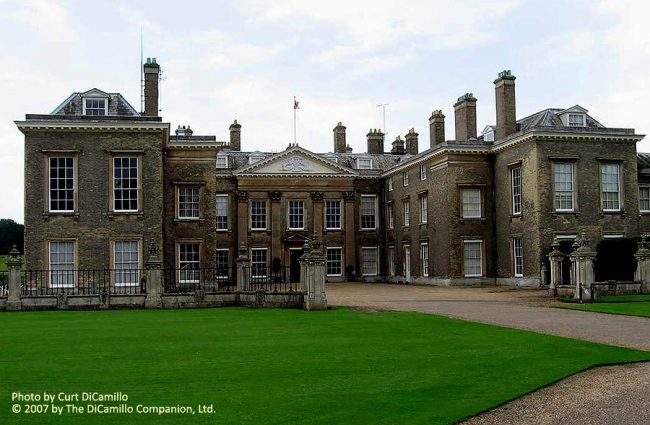
The entrance facade
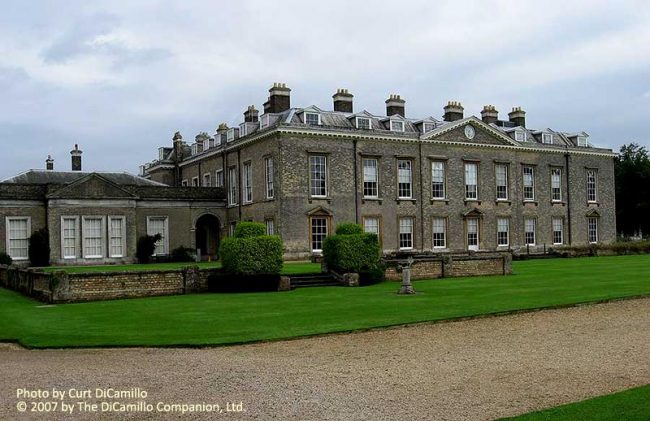
The rear facade
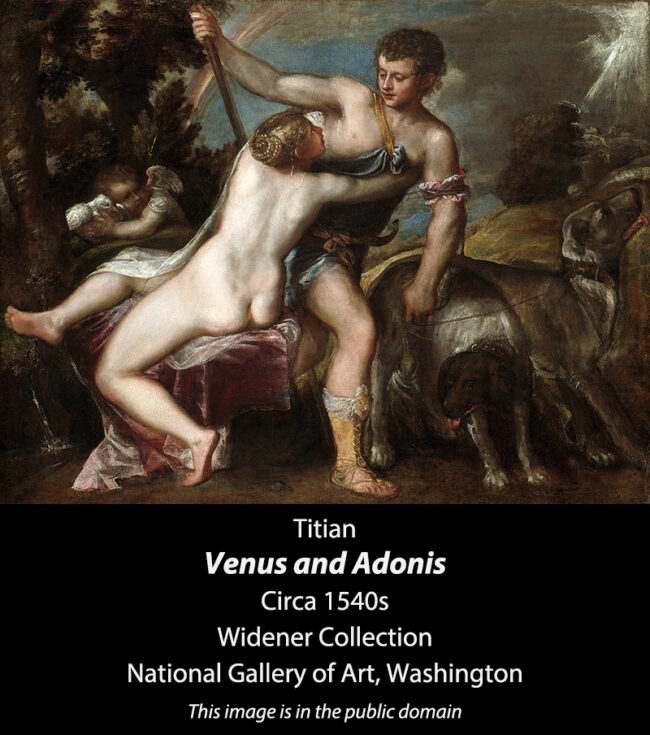
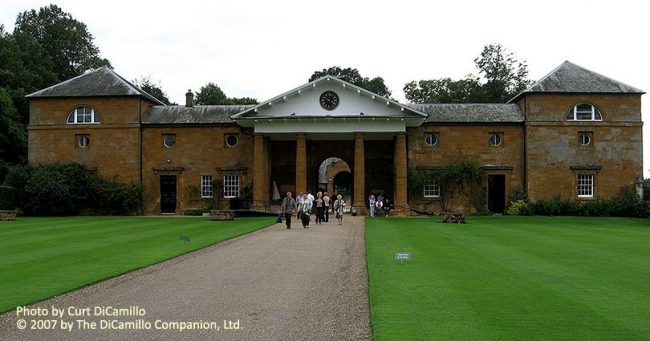
The stables, which houses the Diana Museum.
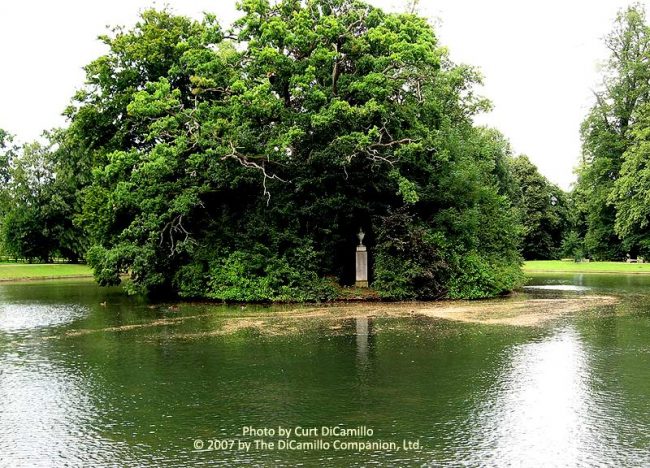
The island, with Diana's grave.
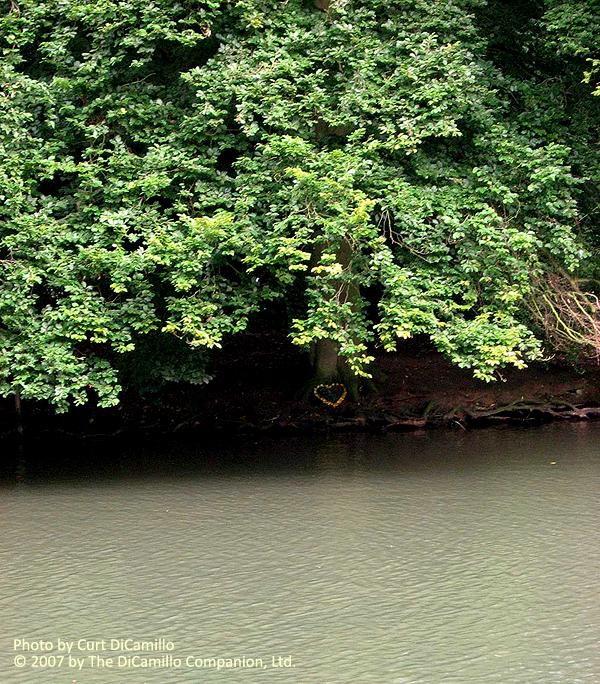
Closeup of the island with memorial to Diana
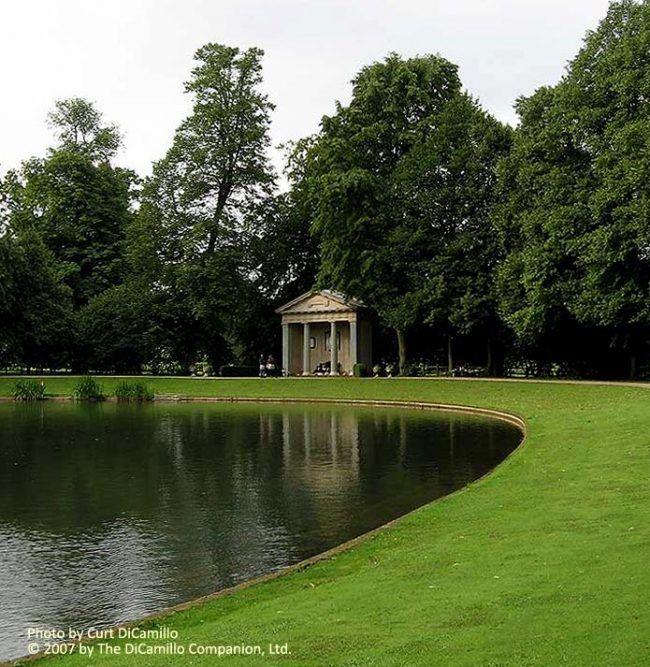
The lake and the Diana Memorial
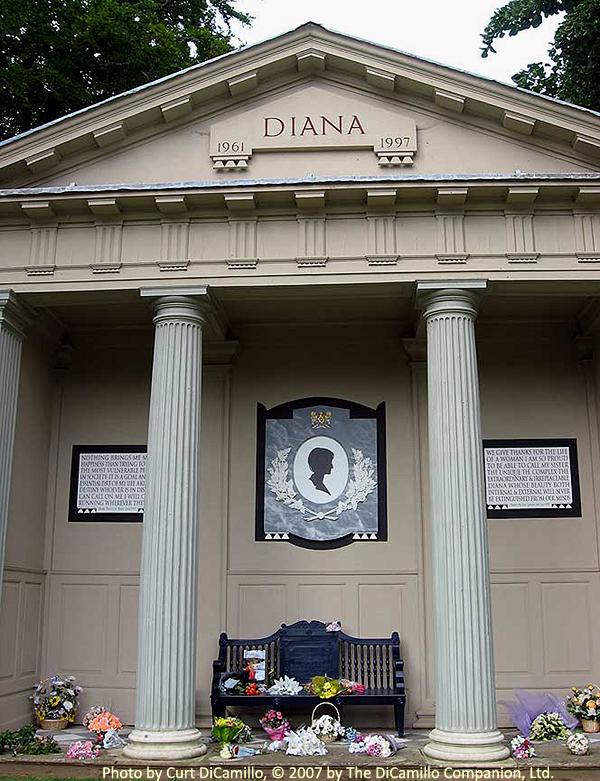
The Diana Memorial
House & Family History: The Spencers first established themselves in Warwickshire in the 15th century (their first manor house was Hodnell in Warwickshire). John Spencer (died 1522) became feoffee of Wormleighton in 1469, a tenant at Althorp in 1486, was granted arms in 1504, acquired the lordship of Wormleighton from the Cope family in 1507 (Wormleighton Manor House was four times the size of Althorp), was granted a license to crenellate in 1512 (for both Wormleighton and Althorp), and was knighted by Henry VIII. Sir John gained his wealth by enclosing lands and converting arable land into pasture; with thousands of sheep, he was a farming entrepreneur who founded the Spencer fortune. Robert Spencer, 1st Baron Spencer of Wormleighton (died October 25, 1627), was the great, great, great, great grandson of Sir John. He was sheriff of Northamptonshire in 1601 and was said to be the wealthiest man in England at the succession of James I. His son, Henry, 3rd Baron (1620-43), was a staunch Royalist and a trusted confidante of Charles I, who created him 1st Earl of Sunderland in June 1643 (he had little time to enjoy his new title, as he was killed at the Battle of Newbury on September 20, 1643). On July 20, 1639, at the age of 19, Henry married Dorothy Sidney at Penshurst in Kent. Dorothy, who was born at Syon House, Middlesex on October 5, 1617, was immortalized by Waller as "Sacharissa" in his poems. She was the daughter of Robert Sidney, 2nd Earl of Leicester, and Dorothy, daughter of Henry Percy, 9th Earl of Northumberland. The only son and heir of Henry and Dorothy was Robert Spencer, 2nd Earl of Sunderland (born Paris August 4, 1640, died Althorp September 28, 1702). In 1665 Robert married Lady Anne Digby, youngest daughter of George Digby, 2nd Earl of Bristol, and Anne Russell, daughter of Francis Russell, 4th Earl of Bedford. When Lady Anne inherited all her brother's estates in 1698, Robert became considerably wealthier. Robert and Anne had three sons and four daughters. One of these sons was the statesman and bibliophile Charles Spencer, 3rd Earl of Sunderland (1674-1722). The 3rd Earl was prime minister in 1718 and was married three times (he was ruined by the South Sea Bubble). First, in 1695, to Lady Arabella Cavendish, who died 1698; secondly, in January 1700, to Lady Anne Churchill, 2nd daughter of the 1st Duke of Marlborough, who died at the age of 28 in April 1716; and lastly, on December 5, 1717, to Judith, daughter of Benjamin Tichborne. From his second marriage (to Anne Churchill) Charles had two sons, who each became, in turn, earl of Sunderland. Robert Spencer (1701-29) succeeded to the earldom as the 4th Earl after his father's death, but died himself in 1729 with no children. Therefore, his brother, Charles Spencer (1706-58), the 3rd Earl's second son, became the 5th Earl of Sunderland. In 1733, upon the death of his aunt, Henrietta Godolphin (née Churchill), 2nd Duchess of Marlborough, Charles succeeded as 3rd Duke of Marlborough (the Dukedom of Marlborough is extremely because it allowed the title to pass through the female line). It was at this point (1733) that the title of earl of Sunderland became a subsidiary title of the dukes of Marlborough (which it remains to this day) and moved away from the Spencers of Althorp. The 3rd Duke of Marlborough's younger brother, The Hon. John Spencer (1708-46), was father of the 1st Earl Spencer, and the ancestor of Diana, Princess of Wales. (George, 5th Duke of Marlborough [1766-1840], took the additional name of Churchill by royal license in 1817; since the 5th Duke, the Marlborough's surname has been Spencer-Churchill. In 1987 Mary Soames wrote a noted biography of the 5th Duke entitled "The Profligate Duke"). By the 18th century the Spencer family stood at the pinnacle of society and was one of the most powerful families in the land. John, 1st Earl Spencer (1734–83), born at Althorp, was the son of The Hon. John Spencer, the grandson of the 3rd Earl of Sunderland, and the great-grandson of Sarah, Duchess of Marlborough (widow of the 1st Duke). Young John inherited multiple fortunes at the age of 12, becoming one of the wealthiest subjects in the kingdom. (On April 3, 1761, he was created 1st Baron Spencer of Althorp and 1st Viscount Spencer. On November 1, 1765, he was created 1st Viscount Althorp and 1st Earl Spencer). At a ball at Althorp on December 20, 1755, John secretly married his sweetheart, the 18-year-old Margaret Georgiana Poyntz, daughter of Stephen Poyntz, in his mother's dressing room (today the Oak Bedroom) at Althorp. Their daughter, also Georgiana (1757–1806), famed for her beauty, went on to marry the 5th Duke of Devonshire and become famous, or infamous, depending on the interpretation, in 18th century society (she is the subject of the popular 1999 book "Georgiana: Duchess of Devonshire" by Amanda Foreman, later turned into the 2008 movie "The Duchess"). Althorp is two stories and covered in gray-white mathematical tiles that are made to look like brick (the original red brick lies beneath the tiles). The entrance façade is a five-bay recessed center with giant Corinthian pilasters and a pediment that is faced with Roche Abbey stone. The north façade is of nine bays with a three-bay pediment. The original Medieval house still survives, encased by later alterations and additions (during the circa 1958 work on the house fragments of the Medieval house were discovered). Circa 1573 Althorp was enlarged with the addition of a courtyard and two projecting wings. Beginning in 1666 the courtyard was covered and the monumental oak grand staircase inserted (the staircase was originally stained to look like walnut; in the 18th century, during Holland's alterations, it was painted white). The Staircase Hall contains, at its west end, a very fine 1758 chimneypiece removed from Spencer House, London. The Elizabethan Long Gallery was converted in 1682 by Lord Sunderland into the current seven-bay 115-foot-long Picture Gallery with oak paneling arranged to fit the 17 frames of portraits by Lely, van Dyck, and others. The gallery chimneypiece, designed by James "Athenian" Stuart, features a frieze that is a copy of that on the Choragic Monument of Lysicrates, and was removed from Spencer House. During a visit in 1688, John Evelyn called Althorp a palace and the state rooms those that "...become a great prince." Between 1729 and 1733 Roger Morris designed the stableblock and worked on the interiors of the house. In 1772 Sir Robert Taylor was employed to make repairs to the roof. The Frenchman Dominique Daguerre was employed in the 1780s to design interiors at Althorp (by 1787 he was working for the Prince Regent at Carlton House). The 2nd Earl Spencer engaged Henry Holland (1787-92) to modernize Althorp and to update Spencer House (Holland's work left Althorp much as it is seen today). And lastly, circa 1877, for the 5th Earl, MacVicar Anderson made many alterations to the interiors and added the Great Dining Room, a double cube meant to be a replica of the ballroom at Buckingham Palace. During the worst of the London Blitz, the 7th Earl decided that the fittings at Spencer House were unsafe in London and decided to move them to Althorp; by the evening of May 12, 1941, all the architectural treasures (chimneypieces, doors, skirting moldings, chair rails, and architraves) had been loaded into vans and were headed to Northamptonshire, where they remain today at Althorp. Pevsner called the 1733 Palladian entrance hall (aka The Wootton Hall) "the noblest Georgian room in the county." The ceiling, which rises to nearly the full height of the house, has coving with deep coffering. The corners contain large cartouches with leaves and eagles, while the frieze features Diana with cherubs, foxes, and hounds. The walls contain large paintings by John Wootton with an equestrian theme. The Sunderland Room has two chimneypieces removed from Spencer House, one designed by James "Athenian" Stuart, and the other by John Vardy. In the continuing tradition of chimneypieces removed from Spencer House, the Marlborough Room also contains two fireplaces from the great London house, one by Peter Scheemakers, the Flemish carver who worked in London in the 18th century (probably most noted for executing the William Kent-designed sculpture of William Shakespeare erected in Westminster Abbey in 1740). The Yellow Drawing Room has a very fine chimneypiece designed by Henry Holland and made by Deval. The South Drawing Room contains a fireplace of 1802 by Lancelot Wood and a doorcase from Spencer House designed by Athenian Stuart. The Patchwork Room contains a fine chimneypiece designed by Humphry Repton removed from Harlestone House. The Small Dining Room contains oak paneling of 1605 and a stone fireplace, both removed from the Spencer's Warwickshire seat, Wormleighton Manor House, and installed at Althorp circa 1925. In 1669 Cosimo III (future Grand Duke of Tuscany) and Count Lorenzo Magolotti visited Althorp. During the time of the 5th Earl ("the Red Earl") in the 19th century, Elizabeth, Empress of Austria, was a frequent house guest at Althorp. Althorp underwent a £10 million restoration in 2010, including a new roof, with the proceeds of the July 2010 Christie's auction of some of the contents funding the restoration work.
Collections: One of van Dyck's masterpieces, "War and Peace," today hangs in the Picture Gallery at Althorp, together with 12 portraits by Sir Peter Lely of ladies of the court of Charles II, collectively called "the Windsor Beauties." There is also a fine portrait of Lady Jane Grey by Lucas de Heere hanging the picture gallery. Also in the collection are "Boy Blowing on a Fire Brand" by Gottfried Schalcken, "George John, Second Earl Spencer with His Sisters" by Angelica Kauffman, a self-portrait by Sofonisba Anguissola, "George John, Second Earl Spencer" by Sir Joshua Reynolds, "Sarah, Duchess of Marlborough's Dogs" by George Stubbs, "The Tribute Money" by Guercino, a self-portrait by Joshua Reynolds, and "Scape Flood" by George Stubbs. Much of the furniture designed by James "Athenian" Stuart for Spencer House, London, is today at Althorp, with a small amount at Kenwood House, London. By 1728 Sir Robert Furnese, 2nd Bt. (died 1733), owned Andrea Sacchi's "Apollo Crowning the Musician Marcantonio Pasqualini," which was once owned by Pope Clement IX. The painting remained at Sir Robert's seat, Waldershare Park, until it passed to his cousin, Henry Furnese (lord of the Treasury, died 1756), at Gunnersbury House. After Henry's death in 1756 the painting was purchased by the 1st Earl Spencer (1734-83), who hung it in the Great Room at Spencer House (and later at Althorp, from whence the painting was sold by the New York City dealers Wildenstein & Co. in 1981 for £270,000 to the Metropolitan Museum of Art). Lord Spencer used Guido Reni's "Liberality and Modesty" (which had a frame designed by James "Athenian" Stuart) as a pendant painting for the Sacchi. The Reni was also purchased by the 1st Lord Spencer from Henry Furnese's estate and remained in the Spencer collection until 1979, when it was sold by the 8th Earl Spencer to Wildenstein & Co., from whom it was purchased by the American collector Peter Sharp; after Sharp's death Sotheby's sold the Reni in New York on January 13, 1994 for $618,500 (both the Sacchi and the Reni were lastly in the collection at Althorp). In the 1670s Robert Spencer, 2nd Earl of Sunderland, purchased Titian's circa 1560s "Venus and Adonis" (see "Images" section). In 1924 the 7th Earl Spencer sold the canvas to Thomas Agnew & Sons, London; Agnews sold the painting in 1925 to Peter A.B. Widener of Lynnewood Hall, Elkins Park, Pennsylvania. In 1943 Peter's son, Joseph Widener, bequeathed the Titian to the National Gallery of Art, Washington. There have been many sales of art from Althrop, particularly in the 1980s by the 8th Earl Spencer. The Marlborough Ice Pails, a pair of solid 22-karat gold ice pails, cylindrical in shape with lion mask handles, were made for the 1st Duke of Marlborough and sold by the 8th Earl to the British Museum in 1982. The two pails together weigh approximately 25 pounds (365 ozs 6 dwts Troy) and are the only surviving English examples made of pure gold. They are very likely unique, as no other gold ice pails from the late 17th or early 18th centuries are documented in Britain or abroad. As is generally found with English gold plate of the period, the pails were not hallmarked and carry no date letter; however, it is very likely they were made in London circa 1700, probably by a Huguenot goldsmith (Huguenot craftsmen were noted for their work in gold plate). David Willaume I is frequently mentioned as a possible maker; he was a Huguenot working in London at the right time and he made the earliest known pair of ice pails: in silver in 1698 for the 1st Duke of Devonshire. Upon her death in 1744 at the age of 85, Sarah, 1st Duchess of Marlborough, one of the richest women in Europe, left the ice pails, together with much else, to her favorite grandson, John Spencer (1708-46). The ice pails remained at Althorp until the sale in 1982 by the 8th Earl. Salvator Rosa's "The Witches' Sabbath," purchased by the 1st Earl Spencer in 1761, was purchased by the National Gallery, London, in 1984 for £350,000. Sir Anthony van Dyck's five Apostle portraits, all of which had come to the Althorp by 1750 and were probably purchased by the 2nd Earl of Sunderland, were sold to the dealers Colnaghi & Co. During 1982 the following were all sold to Colnaghi: Sir Anthony van Dyck's "St. Jerome in Penitence," an oil sketch for the Dresden painting; Francesco Albani's "Holy Family and Angels," purchased by Sarah, 1st Duchess of Marlborough; Carlo Dolci's "Marriage of St. Catherine," purchased by The Hon. John Spencer in 1740; Giovanni Francesco Barbieri's "St. Luke Painting the Virgin," originally an altarpiece from Reggio, Emilia. Sir Joshua Reynolds's "Angelica Kauffmann" was sold to Artemis in 1982. Giovanni Benedetto Castiglione's "Noah's Sacrifice," commented on by Horace Walpole while hanging at Althorp, was sold in 1982; it is today in the collection of the Los Angeles County Museum of Art. Jacopo da Ponte's "Madonna and Child with St. John the Baptist," from the collection of The Hon. John Spencer from before 1746, was sold at Sotheby's in 1985. Stephen Slaughter's "Honorable John Spencer" was sold in 1985. Thomas Hudson's (studio of) "Countess Grenville" was sold at Sotheby's in 1985. A folio of 18th century Roman views was sold to Hazlitt, Gooden and Fox in 1985. A Capodimonte ewer and basin, circa 1750, were purchased by the British Museum in 1986. The Althorp archives and political papers were sold in 1984 to the British Library. Henry Holland's architectural drawings for Althorp, about 185 pieces, were sold in 1985 to the British Library. Gainsborough's portrait drawings commissioned by the 1st Earl Spencer were sold in 1977. The great library of 40,000 rare books, built up by the 2nd Earl Spencer, was sold in 1892 by the 5th Earl. At the time the library, which filled five rooms at Althorp, was considered the greatest private library in Europe. It was purchased by a wealthy widow, Mrs. Enriqueta Augustina Rylands, and moved to Manchester, where she founded The John Rylands Library in memory of her husband (it remains there today as The John Rylands University Library, the University of Manchester's library and information service. It was formed in 1972 from the merger of the library of the Victoria University of Manchester with the John Rylands Library. On October 1, 2004, it joined the library of the University of Manchester Institute of Science & Technology on the merger of the two universities; the library is today the largest non-legal deposit academic library in the United Kingdom). The Althorp sales held by Christie's London July 6-8, 2010, netted a total of £21.1 million. The star of the Old Masters and 19th century art sale on July 6 was the early 17th century "A Commander Being Armed for Battle" by Peter Paul Rubens, which sold for £9,001,250, the second-highest price paid for a work by Rubens at auction (the record is held by "The Massacre of the Innocents," which was sold at Sotheby's in 2002 for £49.5 million to Lord Thomson; it currently holds the record for the highest price paid at auction for an Old Master painting). "David" by Giovanni Francesco Barbieri, also sold at the July 6 Old Masters auction, was hammered down for £5,193,250, a record price for the artist at auction. The Althorp Attic Sale, held July 7-8, 2010, included one of the finest collections of 19th century horsedrawn carriages in existence, including the Spencer State Chariot, which sold for £133,250, against an estimate of £50,000-80,000. The total realized for the carriage collection, and other pieces from Althorp's stables, was £2,024,038, more than double the pre-sale estimates. Also sold was a collection of military uniforms, and other related military items owned by Viscount Althorp, later the 7th Earl Spencer, who served as a captain in the Life Guards during World War I. The uniforms were made by Hawkes & Co. in 1911 for Lord Althrop and were bought by Gieves & Hawkes for £30,000 (the company will add the uniforms to their archives). Sold at Christie's London on July 8, 2010, were 70 lots of art, porcelain, and furniture at Althorp from Spencer House, the family's London townhouse (occupied by them until 1924), which brought a total of £4,857,750. The star pieces were a pair of George II open armchairs made of limewood and sabicu (the very hard wood of a leguminous West Indian tree). The chairs were very probably designed James "Athenian" Stuart for the Painted Room at Spencer House; they sold for £802,850. All of the sales amounts referenced above in the July 6-8, 2010, sales are included in the total of £21.1 million. A diamond tiara featuring continuous running scrolls with a heart-shaped motif in the center (made for Viscountess Montagu in 1767) remains today in the Spencer family collection at Althorp (Lady Diana Spencer wore the tiara at her wedding to the Prince of Wales in 1981).
Garden & Outbuildings: The Althorp Estate today stands at 14,000 acres (in the 19th century it was 27,000 acres). The house is set in 450 acres of parkland, the planting of which began in the 16th century. The stableblock, built in the local yellow ironstone by Charles, 5th Earl of Sunderland, to the designs of Roger Morris, features a deep Tuscan portico modeled on Inigo Jones's St. Paul's Covent Garden. Pevsner believed it could be argued that the stableblock is "the finest piece of architecture at Althorp." The south range of the stableblock features an interior with Tuscan columns that support central groin-vaults and is home to the Diana Museum, split into six aspects of Diana's life: childhood, the royal wedding, charity work, tribute, style & fashion, and the Diana, Princess of Wales Memorial Fund. The most famous part of the museum is a collection of Diana's dresses, including her wedding gown. The lake is known as the round oval, and it is on the island in the lake that Diana is buried. Near the round oval is a wooden temple (the Summer House) with a portico of four Roman Doric columns and a pediment that has been converted to the Diana Memorial (the temple originally stood in the garden of the Admiralty, London). The ashlar-faced gardener's house has a pyramid roof with a central chimney and was designed by Roger Morris. It features a Palladian (Serlian or Venetian) style bay in the middle, taken directly from Palladio's Basilica at Vicenza. Nearby is a fine folly in the form of an archway with quoins, a broken pediment, and a Greek frieze. The ironstone dairy was built in 1786 by Lavinia, Countess Spencer, and features in its interior Wedgwood tiles. The 1611 Hawking Gallery is an oblong building with a porch-like center projection whose second floor was originally open to enable the watching of feats of falconry. The East Lodge of circa 1810 is a one-story building with a raised pedimented center and doorways with Gibbs surrounds. The Brington Lodges are circa 1730. The stone pillars and ironwork to the forecourt are of 1860-63 and were designed by William Teulon.
Chapel & Church: The chapel is located in the east wing of the house and features doorcases from Spencer House. The late 17th century openwork foliage balustrade is from the Duke of Marlborough's pew at St. Albans. There is a bolection chimneypiece by Joshua Marshall and armorial stained glass windows from Wormleighton Manor, brought to Althorp in the 19th century (some of the glass is dated 1588). "The Tribute Money" by Guercino hangs in the chapel.
Architect: Roger Morris
Date: 1729-33Architect: John MacVicar Anderson
Date: Circa 1877Architect: Luke Kirshaw
Date: Circa 1810Architect: John Whiting
Date: Circa 1810Architect: William Milford Teulon
Date: 1860-63Architect: Henry Holland
Date: 1787-92Vitruvius Britannicus: C. II, pls. 95-97, 1717. C. Vol. III, pls. 83, 84, 1725.
John Preston (J.P.) Neale, published under the title of Views of the Seats of Noblemen and Gentlemen in England, Wales, Scotland, and Ireland, among other titles: Vol. III. 1820.
Country Life: XLIX, 714 furniture, 764 furniture, 792, 1921. L, 14, 1921. LXXVIII, 204 [Furniture], 1935. LXXXIII, 293 [Pictures], 1938. CXXVII, 1122, 1186, 1960. CLXX, 375, 1981.
Title: Sotheby's Auction Catalog: The Estate of Peter Jay Sharp, Jan 13, 1994
Author: NA
Year Published: 1994
Reference: Item 73
Publisher: New York: Sotheby's, Inc.
ISBN: NA
Book Type: Hardback
Title: Privilege and Scandal: The Remarkable Life of Harriet Spencer, Sister of Georgiana
Author: Gleeson, Janet
Year Published: 2006
Reference: pg. 5
Publisher: New York: Three Rivers Press
ISBN: 9780307381989
Book Type: Softback
Title: Buildings of England: Northamptonshire, The
Author: Pevsner, Nikolaus; Cherry, Bridget
Year Published: 1995
Reference: pgs. 78-83
Publisher: London: Penguin Books
ISBN: 0140710221
Book Type: Hardback
Title: Althorp: The Story of an English House
Author: Spencer, Charles
Year Published: 1998
Reference: pgs. 13, 22-23, 26-27, 32, 35, 45, 48, 63, 71, 82-87, 97, 121, 131, 139-140, 149, 157
Publisher: London: Viking
ISBN: 0670883220
Book Type: Hardback
Title: Carlton House: The Past Glories of George IV's Palace
Author: Exhbition Catalog
Year Published: 1991
Reference: pg. 11
Publisher: London: The Queen's Gallery
ISBN: 095133736X
Book Type: Softback
Title: Biographical Dictionary of British Architects, 1600-1840, A - SOFTBACK
Author: Colvin, Howard
Year Published: 1995
Reference: pg. 504
Publisher: New Haven: Yale University Press
ISBN: 0300072074
Book Type: Softback
Title: Tiara
Author: Scarisbrick, Diana
Year Published: 2000
Reference: pg. 10
Publisher: San Francisco: Chronicle Books
ISBN: 0811827178
Book Type: Hardback
Title: Treasures of the British Museum
Author: Caygill, Marjorie
Year Published: 1985
Reference: pgs. 172, 174
Publisher: New York: Harry N. Abrams, Inc.
ISBN: 0810916878
Book Type: Hardback
Title: Spencer House Guidebook
Author: Robinson, John Martin (Text); Jones, Stephen (Editor); Rick, Jane (Editor)
Year Published: 1996
Publisher: London: Philip Wilson Publishers Limited
ISBN: NA
Book Type: Light Softback
Title: Spencer House: Chronicle of a Great London Mansion
Author: Friedman, Joseph
Year Published: 1993
Publisher: London: Zwemmer
ISBN: 0302006176
Book Type: Hardback
Title: Disintegration of a Heritage: Country Houses and their Collections, 1979-1992, The
Author: Sayer, Michael
Year Published: 1993
Reference: pgs. 134-135
Publisher: Norfolk: Michael Russell (Publishing)
ISBN: 0859551970
Book Type: Hardback
House Listed: Grade I
Park Listed: Grade II*
Current Seat / Home of: Charles Edward Maurice Spencer, 9th Earl Spencer; Spencer family here since the 16th century.
Past Seat / Home of: Robert Spencer, 1st Baron Spencer, until 1627; John Spencer, 1st Earl Spencer, until 1783; George John Spencer, 2nd Earl Spencer, 1783-1834; John Charles Spencer, 3rd Earl Spencer, 1834-45; Frederick Spencer, 4th Earl Spencer, 1845-57; John Poyntz Spencer, 5th Earl Spencer, 1857-1910; Charles Robert Spencer, 6th Earl Spencer, 1910-22; Albert Edward John Spencer, 7th Earl Spencer, 1922-75; Edward John Spencer, 8th Earl Spencer, 1975-92.
Current Ownership Type: Individual / Family Trust
Primary Current Ownership Use: Private Home
House Open to Public: Yes
Phone: 01604-770-006
Fax: 01604-770-042
Email: [email protected]
Website: https://althorpestate.com/
Historic Houses Member: Yes